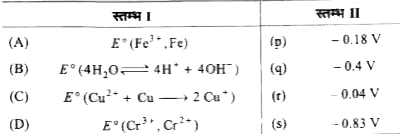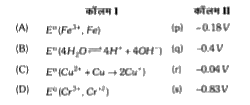(i)E∘(Cu2+,Cu)=0.34V
(ii) E∘(Cu+,Cu)=+0.52V
(iii)E∘[O2(g)+H++4e→4OH−]=+1.23V
(iv)E∘[O2(g)+2H2O+4e→4OH−]=+0.40V
(v) E∘(Cr3+,Cr)=−0.74V
(vi)E∘(Cr2+,Cr)=+0.91V
Match E∘ of the redox pair is List I with the values given in List II and select the correct answer using the code given below the lists.
![(i) E^@ (Cu^(2+),Cu)=0.34V (ii) E^@(Cu^+,Cu)=+0.52V (iii) E^@[O2(g)+H^+ +4e to 4OH^(-) ]=+1.23V (iv) E^@[O2(g) +2H2O +4e to 4OH^(-) ]=+0.40V (v) E^@ (Cr^(3+), Cr)=-0.74V (vi) E^@ (Cr^(2+), Cr)=+0.91V Match E^@ of the redox pair is List I with the values given in List II and select the correct answer using the code given below the lists.](https://d10lpgp6xz60nq.cloudfront.net/physics_images/BBP_RCM_MAC_CHE_C18_E01_019_Q01.png) Solution in Malayalam
Solution in Malayalam
P Q R S
4 1 2 3
P Q R S
2 3 4 1
P Q R S
1 2 3 4
P Q R S
3 4 1 2
D
Topper's Solved these Questions
- ELECTROMOTIVE FORCE BOOK - BODY BOOKS PUBLICATIONCHAPTER - ELECTROMOTIVE FORCE EXERCISE - PROBLEMS
50 Videos
- ELECTROCHEMISTRYBOOK - BODY BOOKS PUBLICATIONCHAPTER - ELECTROCHEMISTRYEXERCISE - EXAMPLES
134 Videos
- General Principles and Processes of Isolation of ElementsBOOK - BODY BOOKS PUBLICATIONCHAPTER - General Principles and Processes of Isolation of ElementsEXERCISE - Example
108 Videos
Similar Questions
Calculate the reduction potentials for the following half cells:
Ag∣Ag+(10−5M),E∘Ag+,Ag=0.80V
View SolutionSalt bridge Is used because it_________.
View SolutionThe scientific and technological process used for isolation of the metal from its ores is known as metallurgy. Name the method used for removing gangue from sulphide ores.
View SolutionE^(c-) for Cr^(3+)+3e^(-) rarr Cr and Cr^(3+)+e^(-) rarr Cr^(2+) are -0.74 V and -0.40V , respectively, E^(c-) for the reaction is Cr^(+2)+2e^(-) rarr Cr
View SolutionGiven: (i) Cu^(2+)+2e^(-) rarr Cu, E^(@) = 0.337 V (ii) Cu^(2+)+e^(-) rarr Cu^(+), E^(@) = 0.153 V Electrode potential, E^(@) for the reaction, Cu^(+)+e^(-) rarr Cu , will be
View SolutionThe standard reduction potential data at 25∘C is given below
E∘(Fe3+,Fe2+)=+0.77V,
E∘(Fe2+,Fe)=−0.44V,
E∘(Cu2+,Cu)=+0.34V,
E∘(Cu+,Cu)=+0.52V,
E∘(O2(g)+4H++4e−→2H2O]=+1.23V
E∘[(O2(g)+2H2O+4e−→4OH−)]=+0.40V,
E∘(Cr3+,Cr)=−0.74V,
E∘(Cr2+,Cr)=−0.91V,
Match E∘ of the redox pair in List-I with the values given in List-II and select the correct answer using the code given below teh lists:
List−IList−II(P)E∘(Fe3+,Fe)(1)−0.18V(Q)E∘(4H2O⇔4H++4OH+)(2)−0.4V(R)E∘(Cu2++Cu→2Cu+)(3)−0.04V(S)E∘(Cr3+,Cr2+)(4)−0.83V
Codes:
View SolutionGiven the standard reduction potentials, which statement is correct?
Cu2(aq)+2e−→Cu(s)E∘=0.34V2H+(aq)+2e−→H2(g)E∘=0.0VCr3+(aq)+2e−→Cr(s)E∘=−0.73V
View SolutionGiven:
(i) Cu2++2e−→Cu,E∘=0.337V
(ii) Cu2++e−→Cu+,E∘=0.153V
Electrode potential, E∘ for the reaction, Cu++e−→Cu, will be
View Solutionदिया है
(i) Cu2++2e−→Cu, E∘=0.337V
(ii) Cu2++e−→Cu+,E∘, E∘=0.153V
अभिक्रिया Cu++e−→Cu के लिए इलेक्ट्रोड विभव E∘ होगा
View SolutionE^@ values for the half cell reactions are given below : Cu^(2+) + e^(-) to Cu^(+) , E^@ =0.15 V Cu^(2+) + 2e^(-) to Cu, E^@ =0.34 V What will be the E^@ of the half-cell : Cu^(+) + e^(-) to Cu ?
View SolutionGiven that the standard reduction potential (E^(@)) of Cr^(3+) | Cr and Cr^(2+) |Cr are -0.74 and -0.91 V respectively. The E^(@) of Cr^(3+) |Cr^(2+) is:
View SolutionGiven that the standard potentials ((E^(@))) of CU^(2+)//Cu and CU^(+)//Cu are 0.34V and 0.522V respectively , the E^(@) of CU^(2+)//CU^(+) is :
View SolutionThe standard reduction potential data at 25∘C is given below
E∘(Fe3+,Fe2+)=+0.77V,
E∘(Fe2+,Fe)=−0.44V,
E∘(Cu2+,Cu)=+0.34V,
E∘(Cu+,Cu)=+0.52V,
E∘(O2(g)+4H++4e−→2H2O]=+1.23V
E∘[(O2(g)+2H2O+4e−→4OH−)]=+0.40V,
E∘(Cr3+,Cr)=−0.74V,
E∘(Cr2+,Cr)=−0.91V,
Match E∘ of the redox pair in List-I with the values given in List-II and select the correct answer using the code given below teh lists:
List−IList−II(P)E∘(Fe3+,Fe)(1)−0.18V(Q)E∘(4H2O⇔4H++4OH+)(2)−0.4V(R)E∘(Cu2++Cu→2Cu+)(3)−0.04V(S)E∘(Cr3+,Cr2+)(4)−0.83V
Codes:
View Solutionमानक अपचायक विभव 25∘C पर निम्नलिखित हैं
E∘(Fe3+.Fe2+)=+0.77VE∘(Fe2+/Fe)=−0.44VE∘(Cu2+/Cu)=+0.34VE∘(Cu+/Cu)=+0.52V
(E∘(O2(g)+4H++4e−→2H2O)=+1.23V,),(E∘(O2(g)+2H2O+4e−→4OH)=+0.40V),(E∘(Cr3+/Cr)=−0.74V, E∘(Cr2+/Cr)=−0.71V)
स्तम्भ I में दिए गए रेडॉक्स युग्मों को स्तम्भ II में दिए गए अपचायक विभव से सुमेलित कीजिए तथा स्तम्भ के नीचे दिए गए कोड का प्रयोग करके सही उत्तर चुनिए |

View Solutionमानक अपचायक विभव 25∘C पर निम्नलिखित है
E∘(Fe3+,Fe2+)=+0.77V
E∘(Fe2+.Fe)=−0.44V
E∘(Cu2+.Cu)=+0.34V,
E∘(Cu+.Cu)=+0.5V,
E∘(O2(g)+4H++4e−→2H2O)+1.2SV,
E∘(O2(g)+2H2O+4e−→4OH)=+0.40V
E∘(Cr3+.Cr)=−0.74V,
E∘(Cr2+.Cr)=−0.91V
कॉलम I में दिये गये रेडॉक्स युग्मों को कॉलम II में दिये गये अपचायक विभव से सुमेलित कीजिए।

View Solution
